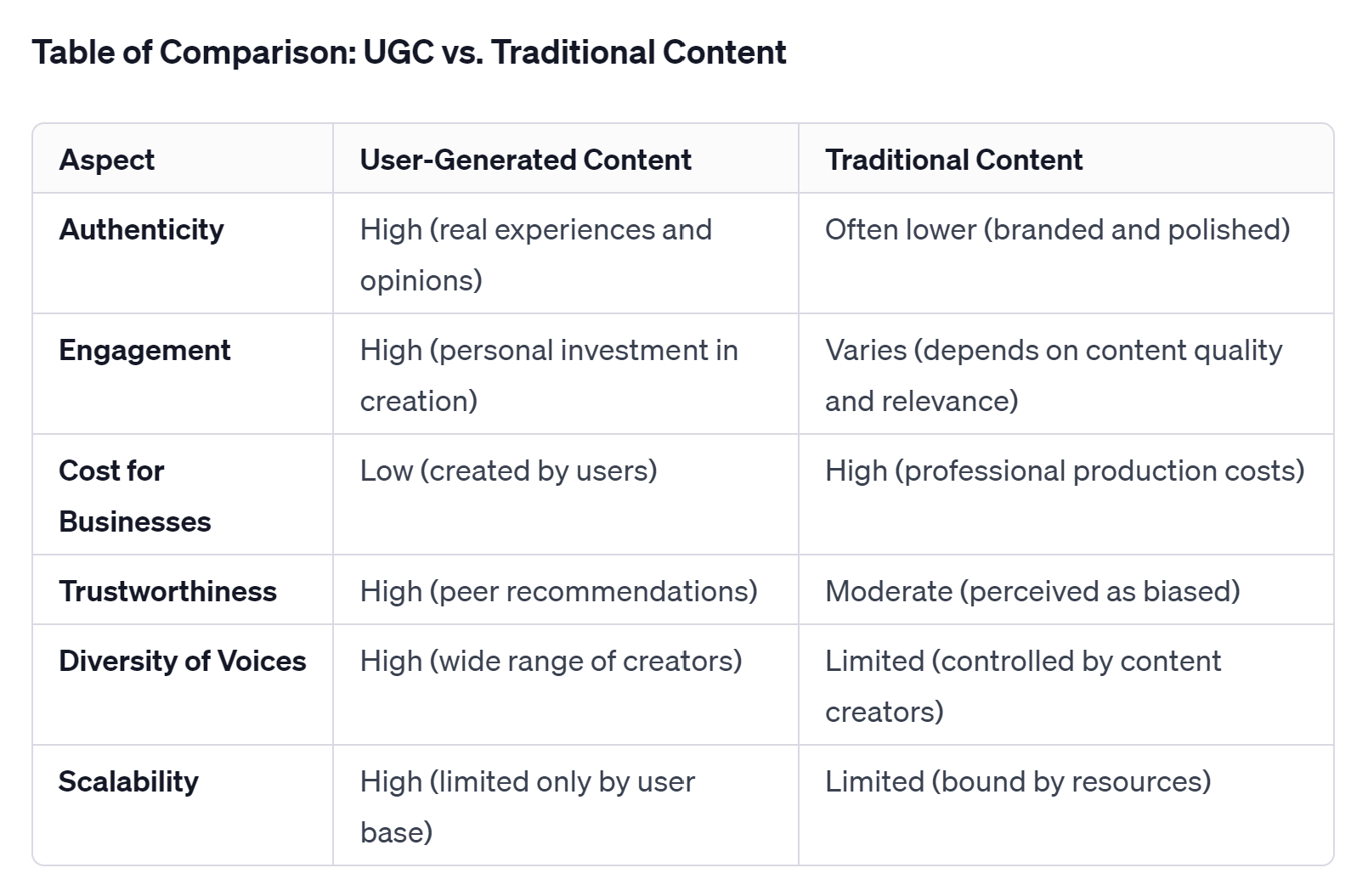Table of Contents
Asset: User-Generated Content
User-generated content, which encompasses anything from social media posts and blog entries to reviews and videos created by users rather than brands, has become an invaluable asset for businesses and online communities alike.
The Growing Importance of UGC
In the early days of the internet, content creation was largely the domain of professionals. Today, however, the democratization of content creation tools and platforms has empowered everyday users to produce and share their own content. This shift has profound implications. UGC not only diversifies the type of content available online but also adds a layer of authenticity that is often lacking in professionally produced content. In a world where consumers are increasingly skeptical of traditional advertising, UGC offers a breath of fresh air – content that is raw, real, and relatable.
For businesses, UGC represents a goldmine of opportunity. When customers create and share content about a brand or product, they are not just engaging with the brand; they are actively promoting it. This form of word-of-mouth marketing is incredibly powerful, as people tend to trust recommendations from peers more than any form of branded advertising. Moreover, UGC can drive engagement, increase brand loyalty, and provide invaluable insights into customer preferences and behaviors.
UGC’s Benefits for Online Communities
Online communities thrive on user participation, and UGC is the fuel that keeps the conversation going. By encouraging users to share their thoughts, experiences, and creations, community managers can foster a sense of belonging and engagement. This user-driven content not only keeps the community active and vibrant but also ensures that it remains relevant and responsive to its members’ interests and needs.
The Synergy of UGC and Business Benefits
Creating Engaging and Interactive Platforms
The creation of user-generated content (UGC) is inextricably linked to the platforms that host it. These platforms must not only attract users but also actively encourage and facilitate content creation. This section explores how interactive platforms can spur UGC, provides examples of successful platforms, and offers tips for designing user-friendly interfaces and features that engage users.
Encouraging UGC Through Interactive Platforms
The cornerstone of any UGC-centric platform is its ability to engage users interactively. Interactive platforms are digital environments that respond to user actions, creating a dynamic and participatory experience. This interactivity is crucial for encouraging UGC, as it transforms passive consumers into active creators. When users interact with a platform, they are more likely to feel a sense of ownership and investment, prompting them to contribute content.
Platforms that successfully encourage UGC often do so by integrating features that make content creation both accessible and appealing. For example, social media platforms use ‘like’ and ‘comment’ features to provide immediate feedback, encouraging users to share more content to garner reactions. Additionally, interactive tools such as easy-to-use video editors, photo filters, and text overlays reduce the barrier to content creation, enabling more users to participate.
New York City
Active Speakeasies: Find a Bar
These secret bars and clubs operate in defiance of privacy, and patrons are supposed to “speak easy” about their existence.
These Stand Out for User Generated Content:
Instagram: Instagram revolutionized photo sharing by offering an array of filters and editing tools. This simplicity and creativity turned ordinary users into photographers, encouraging them to share their daily lives and artistic expressions.
TikTok: TikTok’s success lies in its highly interactive interface, which makes video creation and sharing both easy and entertaining. Its features like duets, challenges, and user-friendly editing tools have created a vibrant community of content creators.
YouTube: As a platform for video sharing, YouTube empowers users with tools for content creation and monetization. It’s a prime example of a platform where users can turn their content creation efforts into a career.
Reddit: Reddit’s platform is built around community interaction and content sharing. Its upvote/downvote system and subreddits create a highly participatory environment where users are motivated to contribute and engage with content.
Tips for Designing User-Friendly Interfaces and Engaging Features
Creating a platform that encourages UGC involves thoughtful design and feature integration. Here are some tips for designing user-friendly interfaces and engaging features:
Simplicity and Accessibility: The interface should be intuitive and easy to navigate. Complex or cumbersome platforms can deter users from contributing. Streamlined processes for uploading, editing, and sharing content are essential.
Interactive Elements: Incorporate interactive elements like comment sections, reaction buttons (like, share, etc.), and forums. These elements create a sense of community and engagement, prompting users to participate actively.
Customization Options: Allow users to personalize their experience. Customizable profiles, content filters, and notification settings can make users feel more at home on the platform, increasing their likelihood to contribute content.
Mobile Responsiveness: With the increasing use of smartphones, ensuring that the platform is mobile-friendly is crucial. Features should be easily accessible on various devices and screen sizes.
Gamification: Introducing elements of gamification, such as badges, leaderboards, or challenges, can significantly boost user engagement and content creation. These elements tap into the user’s competitive spirit and desire for recognition.
Feedback and Analytics: Offer users feedback on their content, such as views, likes, and comments. Analytics tools can also help users understand their audience better, encouraging them to create more targeted and appealing content.
Community Building Features: Encourage community building through features like groups, forums, or collaborative projects. When users feel part of a community, they are more likely to contribute actively.
Regular Updates and Innovations: Keep the platform fresh and engaging by regularly updating features and introducing new tools. Staying abreast of technological advancements and user preferences is key to maintaining an active user base.
Offering Incentives and Rewards
In the realm of user-generated content (UGC), the motivation to create and share often hinges on the incentives provided. Incentives serve as catalysts, transforming passive users into active creators. This section delves into how incentives motivate content creation and explores various types of incentives, culminating with a case study of a successful incentive program.
Motivating Users with Incentives
Incentives play a pivotal role in human behavior. In the context of UGC, they act as motivators by providing users with tangible or intangible rewards for their efforts. This motivation is rooted in basic psychological principles: people are more likely to engage in an activity if they perceive a clear reward for doing so. Incentives can drive users to invest time and creativity in generating content, thereby enriching the platform with diverse and dynamic contributions.
The effectiveness of incentives in motivating content creation is twofold. Firstly, they provide immediate gratification for the user’s contribution, whether it’s through monetary rewards, recognition, or exclusive benefits. Secondly, they create a positive feedback loop – as users are rewarded, they feel valued and are encouraged to contribute more.
Types of Incentives
Incentives can take various forms, each appealing to different user motivations.
Monetary Rewards: Offering financial incentives, such as cash prizes, commissions, or revenue sharing, can be a powerful motivator. This is particularly effective for platforms where users invest significant time and effort in content creation.
Recognition: Public acknowledgment of a user’s contribution can be highly motivating. This can include featuring their content on the platform, shoutouts on social media, or awards and titles. Recognition satisfies the human desire for social validation and can foster a loyal user base.
Access to Exclusive Content: Providing access to exclusive content or features as a reward for content creation can incentivize users. This could include access to premium features, exclusive content, or early access to new products or services.
Community Status: Elevating a user’s status within the community can be a significant motivator. This can be achieved through badges, leaderboards, or special roles within the platform.
Personal Growth Opportunities: Offering opportunities for personal or professional growth, such as educational resources, mentorship, or exposure, can also motivate content creation, particularly in professional or niche communities.
Case Study: Starbucks' #WhiteCupContest
A prime example of a successful incentive program is Starbucks’ #WhiteCupContest. Launched in 2014, this campaign encouraged customers to doodle on their Starbucks cups and share the images on social media using the hashtag #WhiteCupContest. The incentive? The winning design would be reproduced on a limited-edition Starbucks reusable cup.

Key Elements of the Campaign
Participation Ease: The contest was simple and accessible – customers only needed a cup and a marker to participate, making the barrier to entry extremely low.
Creativity Encouragement: The campaign tapped into customers’ creativity, allowing them to showcase their artistic skills.
Social Media Integration: By leveraging social media, Starbucks ensured wide visibility for the entries, providing participants with recognition and a sense of community.
Tangible Reward: The winning design being featured on a Starbucks cup was a significant incentive, offering the artist not just recognition, but a form of immortality in the Starbucks universe.
Outcomes
The #WhiteCupContest was a resounding success. It generated massive engagement on social media, with customers eagerly sharing their designs. The campaign not only created a buzz around the brand but also cultivated a sense of community among Starbucks patrons.
Moreover, it provided Starbucks with a wealth of user-generated content that could be used in future marketing efforts.
Building a Community Around Your Brand
Fostering a vibrant community around your brand is not just beneficial; it’s a strategic imperative. This community becomes the lifeblood for generating user-generated content (UGC), serving as a platform for engagement, loyalty, and brand advocacy. Here, we explore the importance of community building in UGC and delve into strategies for creating and nurturing online communities, including an example of a brand that has successfully achieved this.
Importance of Community Building in Encouraging UGC
Community building is pivotal in creating an environment where UGC can thrive. A strong community offers a sense of belonging and identity to its members, encouraging them to express themselves and share their experiences. This shared identity often revolves around a common interest or affinity for a brand, making the content created highly relevant and engaging.
Furthermore, a vibrant community acts as a feedback loop for UGC. It provides immediate responses to content shared, whether through likes, comments, or shares, validating the user’s effort and motivating continuous contribution. This interaction not only fosters a positive environment but also cultivates a sense of ownership and pride among members, leading to more authentic and passionate content.



Strategies for Creating and Nurturing Online Communities
Establish a Clear Brand Identity and Values: Your community should resonate with your brand’s identity and values. This clarity helps attract like-minded individuals and sets the tone for the community’s interactions and content.
Engage Actively with Your Community: Regular interaction from the brand’s side is crucial. Responding to comments, participating in discussions, and acknowledging user content helps build trust and engagement.
Create Exclusive Spaces for Interaction: Platforms like forums, social media groups, or branded apps provide a dedicated space for community members to interact, share content, and build relationships.
Encourage Peer-to-Peer Interaction: Facilitate opportunities for community members to connect and interact with each other. This could be through community events, challenges, or user spotlights.
Provide Value Through Content and Resources: Offer valuable content and resources that cater to the interests and needs of your community. This could include educational materials, insider news, or entertaining content.
Recognize and Reward Contributions: Acknowledge and reward active community members. This recognition can be in the form of shoutouts, featuring their content, or providing exclusive perks.
Foster a Safe and Inclusive Environment: Establish community guidelines to ensure a safe and welcoming environment for all members. This includes moderating content and addressing any negative behavior.
Leverage User Feedback: Use community feedback to improve products, services, and the community experience itself. This involvement makes members feel valued and part of the brand’s journey.
Community: LEGO's Approach
LEGO, the renowned toy company, exemplifies successful community building. LEGO has cultivated a passionate community of fans, both young and old, around its brand.
Key Elements of LEGO’s Approach
LEGO Ideas Platform: LEGO Ideas is a platform where fans can submit their own LEGO set designs. The community votes on these ideas, and selected designs are turned into official LEGO sets. This initiative not only generates a wealth of UGC but also directly involves the community in product development.
Engaging Across Multiple Channels: LEGO engages with its community through various channels, including social media, forums, and events. This multi-channel approach ensures broad and effective engagement.
Fostering a Creative Environment: LEGO encourages creativity and sharing by hosting contests, showcasing user creations, and providing resources for builders of all levels.
Events and Collaborations: LEGO frequently organizes events and collaborations, such as the LEGO World Expo, where fans can meet, share ideas, and celebrate their creations.
Outcomes
LEGO’s community-centric approach has led to a highly engaged and loyal fan base. The UGC generated through LEGO Ideas and other initiatives not only provides LEGO with fresh ideas but also keeps the community actively involved and invested in the brand.
This engagement has contributed significantly to LEGO’s enduring popularity and market presence.
Providing Tools and Resources for Content Creation
The democratization of content creation is largely driven by the availability and accessibility of tools and resources. This section discusses how these tools and resources aid users in creating content and provides a list of useful aids that can empower users to contribute more effectively and creatively to user-generated content (UGC).
Empowering Users with Tools and Resources
The ability to create engaging content is not solely a matter of talent or creativity; it’s also about having the right tools at one’s disposal. Tools and resources for content creation democratize the process, allowing individuals with varying levels of skill and experience to participate. They serve as enablers, reducing technical barriers and making content creation more accessible to a broader audience.
Firstly, these tools can significantly simplify the content creation process. For instance, easy-to-use video editing software or blog templates allow users to produce polished content without needing extensive technical knowledge. Secondly, they provide users with new possibilities for creativity, enabling them to experiment with different formats and styles. This not only enhances the quality of the content but also makes the creation process more enjoyable and engaging.
Furthermore, educational resources such as guides and tutorials are instrumental in helping users improve their skills. These resources can foster a learning environment within the community, encouraging users to refine their content creation abilities and share their knowledge with others. This not only improves the quality of individual contributions but also elevates the overall standard of content within the community.
List of Useful Tools and Resources
Content Creation Software
Video Editing: Tools like Adobe Premiere Rush, iMovie, and InShot offer user-friendly interfaces for video editing.
Graphic Design: Canva and Adobe Spark provide templates and design elements for creating graphics and social media posts.
Photo Editing: Apps like Snapseed and VSCO offer powerful photo editing capabilities on mobile devices.
Content Management Platforms
Blogging: WordPress and Medium offer intuitive platforms for blogging, complete with templates and SEO tools.
Social Media Management: Hootsuite and Buffer help in scheduling and managing posts across multiple social media platforms.
Interactive Content Tools
Tools like Crello and Adobe Spark allow users to create interactive content like quizzes, polls, and infographics.
Guides and Tutorials
Websites like Skillshare, Udemy, and YouTube are rich sources of tutorials covering various aspects of content creation, from basic skills to advanced techniques.
Content Creation Kits
Brands can provide content creation kits to their community, which might include templates, brand-specific graphics, and guidelines to maintain a consistent brand voice.
Community Forums and Workshops
Online forums and workshops can be valuable resources for sharing knowledge, tips, and best practices among community members.
By equipping users with the means to easily and creatively generate content, brands can not only enhance the quantity and quality of UGC but also foster a more engaged and skilled community. The tools and resources listed above are just a starting point, and brands should continually seek to understand and cater to the evolving needs of their content creators.
Recognizing and Showcasing User Content
The act of recognizing and showcasing user-generated content (UGC) is a powerful tool in the arsenal of content strategy. It’s not just about acknowledging the efforts of your audience; it’s about celebrating their creativity and contributions, thereby encouraging a continuous cycle of engagement and content creation. This section explores the impact of such recognition on user motivation and the various ways in which user content can be featured.
Impact of Recognizing and Showcasing User Content
Recognizing user content does more than just flatter the creators; it validates their efforts and talents, which is a significant motivator. When a user’s content is highlighted by a brand, it sends a message that their contribution is valued and appreciated. This recognition can lead to a deep sense of loyalty and connection with the brand, transforming ordinary users into brand advocates.
Moreover, showcasing user content can inspire other community members. It sets a precedent, demonstrating the kind of content that is appreciated and celebrated, which in turn can spark creativity in others. This not only increases the volume of UGC but also elevates its quality, as users strive to create content that might be similarly recognized.
The psychological impact of this recognition cannot be overstated. It taps into fundamental human desires for validation and belonging, making users feel like an integral part of the brand’s narrative. This sense of belonging is crucial in building a strong, active community around a brand.
Ways to Feature User Content
Social Media
User Spotlights: Dedicate posts to highlighting user content, tagging, and thanking the creators. This can be done through regular features like “Fan of the Week” or “Post of the Month.”
Story Takeovers: Allow users to take over the brand’s social media stories for a day, showcasing their perspective or how they use your products/services.
Hashtag Campaigns: Create brand-specific hashtags for users to use with their content, making it easier to find and feature these posts.
Websites
User Galleries: Dedicate a section of your website to a user content gallery, showcasing the best user contributions.
Testimonials and Case Studies: Feature user stories, testimonials, or case studies on your website, highlighting how real people are engaging with your brand.
Marketing Campaigns
Incorporate UGC in Ads: Use user content as part of your advertising campaigns, showcasing real-life examples of your product or service in action.
Email Newsletters: Include a section in your newsletters that features user content, providing regular exposure to your email subscriber base.
Product Packaging and Collateral:
Consider using user-created images or quotes on your product packaging or in promotional materials, bringing the voice of your customers directly to potential new customers.
Events and Contests:
Host events or contests that encourage users to create content, with the promise of featuring winning entries in high-profile ways.
Collaborative Projects:
Involve users in collaborative projects, such as creating a community mural or a compilation video, which can then be showcased on various platforms.
Bottom Line
We began by discussing the importance of Creating Engaging and Interactive Platforms, highlighting how a user-friendly and responsive interface can significantly boost user participation and content creation. We then delved into the power of Offering Incentives and Rewards, a strategy that effectively motivates users by acknowledging their efforts and contributions. The critical role of Building a Community Around Your Brand was our next focus, emphasizing the need for a strong, interconnected community as the backbone of sustained UGC.
We also explored the significance of Providing Tools and Resources for Content Creation, which equip users with the necessary means to express their creativity and share their experiences. Lastly, the article underscored the impact of Recognizing and Showcasing User Content, a method that not only values existing contributions but also inspires future ones.
As you consider these strategies, remember that there is no one-size-fits-all solution. The digital world is characterized by its diversity and constant change, necessitating a flexible and experimental approach to encouraging UGC. Experiment with different methods, mix and match strategies, and don’t hesitate to innovate. The goal is to find the unique blend that resonates with your audience and aligns with your brand values. Looking ahead, the future of UGC is as promising as it is challenging. As technology continues to advance, new platforms and tools will emerge, expanding the horizons of what users can create and share. The evolution of UGC will likely see deeper integration with emerging trends like augmented reality, virtual reality, and AI-driven content, offering even more exciting avenues for user participation and creativity.
The brands and communities that will thrive are those that not only adapt to the new trends but also stay true to the core principle of UGC – valuing and amplifying the voice of the user. By fostering an environment where users feel empowered, appreciated, and connected, you create more than just content; you build a living, breathing community that grows with your brand. In conclusion, the journey of encouraging user-generated content is an ongoing one, rich with opportunities for connection, creativity, and growth. As you embark on or continue this journey, keep in mind the endless possibilities that lie in the collective creativity of your users. Their voices are not just echoes in the digital space; they are the heartbeat of your brand’s story and the architects of its future.

